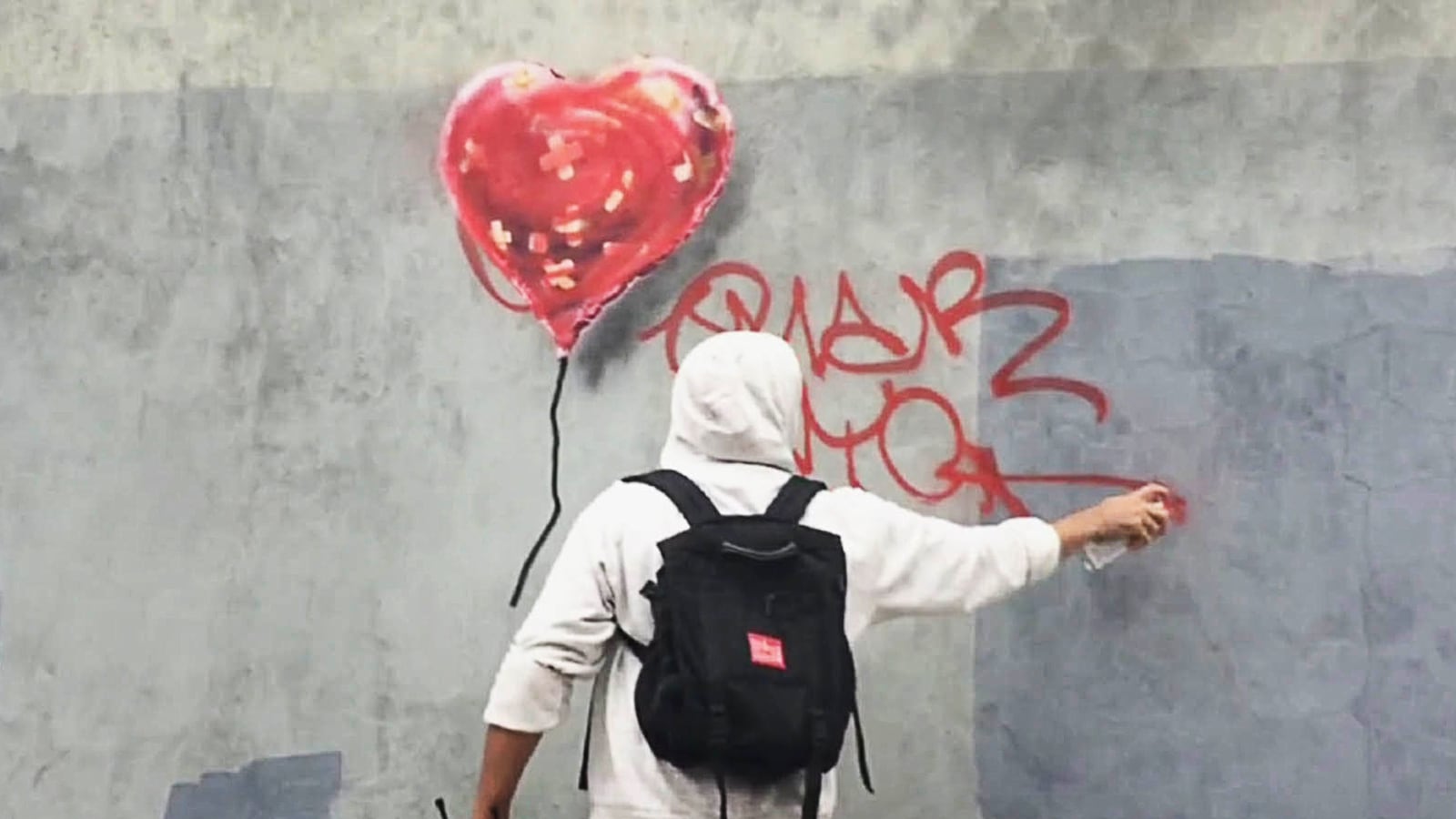For one month in 2013, a British street artist known by the nom de plume of Banksy hypnotized the city of New York. This was not an easy feat. Those of us who live here are a fickle bunch with fleeting attention spans. Even asinine occurrences like a man taking a piss on the sidewalk in broad daylight or a used condom being tied to a subway pole get little more than a shrug or, at most, a snap from a cell phone camera. But thanks to a heavily trafficked website, the power of social media, and the type of intrigue and obsession Banksy currently commands from an ever-growing fan base, the anonymous prankster’s month-long residency turned the streets of New York into a widely publicized city-wide scavenger hunt.
As always, Banksy’s project was an independent operation, sponsored by no art dealer or organization. It was just the anonymous artist and his group of pranksters using New York as their unofficial playground. Now this one-month adventure has been turned into a documentary, fittingly titled Banksy Does New York, set to air Nov. 17 on HBO. (According to Banksy’s website, the artist is, unsurprisingly, not involved with the film.)
What made BanksyNY so special? That depends on whom you ask. As the film points out, Artforum.com, the website for the popular monthly art magazine, did its best to ignore the spectacle, as did the also-snobbish New York Observer. The denunciations of the work aren’t completely unfounded. There’s a lack of subtlety in Banksy’s art. No matter how admirable or inspiring his message appears to be, it often hits you over the head like a blunt instrument. Strangely enough, fellow street artists found themselves aligned with this highfalutin way of thinking, though for slightly different reasons. They don’t consider Banksy one of their own because he uses stencils, which is anathema to a true graffiti master.
But to fall into this rather snooty category would be to ignore the millions of Banksy followers and newfound fans who became enthralled with what was happening on the street. You couldn’t deny the impact BanksyNY was having on the community. Here was a well-known name in the art world keeping the entire city on its toes with his (or her!) mix of graffiti, sculptures, mixed media, and other pieces that popped up seemingly overnight. Fans and novices soon became swept up in the movement, tracing each work like buried treasure. Adults skipped work to see his installations. Lesser-known street artists tried to deface the pieces. People fought. Children cried. When was the last time you heard an artist inspiring something like that on such a wide scale?
The film is an overall reflection of this––a day-to-day look at the aftermath of what Banksy shared every morning on his dedicated Instagram account, where he would post a photo of his newest piece, a brief audio recording a la museum tour guide detailing what the work was about, and a hint to its location. There was the one piece that read “Occupy Wall Street: The Musical,” scrawled on a red brick wall in Bushwick; there was the statue of Ronald McDonald getting his shoe shined by an overworked kid in the Bronx; there were the colorful paintings hanging underneath a bridge in Chelsea; there was a Sphinx-like sculpture sitting in an empty lot in Queens. Each one had a specific message and feel to it, many incorporating the notion of an ever-changing city and the growing income equality fight. People from all over New York, so-called “Banksy-hunters,” would rush to get to these locations first, take a photo, and share it with their friends.
Many of the pieces have since been painted over, a response that plays nicely into the reaction to the art. Everyone from the people defacing or stealing the works, to those who worshipped at their altar, to Mayor Bloomberg––who turned into J. Edgar Hoover for a month by declaring Banksy Public Enemy No. 1 and calling for an immediate end to his delinquent ways––became tangled in the Banksy web. We were all participating in it some way. It was performance art.
Banksy Does New York compiles these moments like a scrapbook. Ultimately, though, it feels like more of a compendium piece than a fully formed documentary. But a compendium piece to what, exactly? Even though the artist didn’t sanction the film, it acts as a continuation of our reaction to his work and residency. Though if the documentary is part of the art, doesn't that mean everything pertaining to it is? Is this article you are reading now a part of BanksyNY? Where does it end?
The short answer: wherever you want it to. There is something terrifically punk about a high-profile artist tagging the biggest city on the globe in an increasingly visible world where staying anonymous is all but impossible. Banksy’s currency isn’t just his art, it’s his ambiguity; he’s doing it without giving a direct reason. Graffiti was borne out of the South Bronx streets as one of the key pillars of the hip-hop movement. Artists would use pen names and scrawl them across subway cars, walls, shops, and office buildings. Banksy might not be a graffiti artist in the traditional sense of the term, but his idea of adventure and his ability to keep his identity a secret fits well within these principles. Of course, everything is open to interpretation and always will be unless Banksy says anything more concrete than what he allegedly told the Village Voice during the residency:
“There is absolutely no reason for doing this show at all. I know street art can feel increasingly like the marketing wing of an art career, so I wanted to make some art without the price tag attached. There's no gallery show or book or film. It's pointless. Which hopefully means something.”






